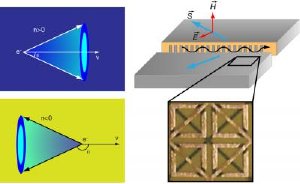Nov 3 2009
A team of physicists has directly observed a reverse shock wave of light in a specially tailored structure known as a left-handed metamaterial. Although it was first predicted over forty years ago, this is the first unambiguous experimental demonstration of the effect. The research is reported in Physical Review Letters and highlighted with a Viewpoint in the November 2 issue of Physics.
 (Top left) Schematic of Cerenkov radiation in a conventional natural medium with positive refractive index, such as water, in which the radiation falls in a cone in the forward direction. (Bottom left) Schematic of backward Cerenkov radiation in a left-handed medium, showing the reversed cone. (Right) Schematic of the two-dimensional experimental configuration and the photographic image of the negative index metamaterials used to demonstrate backward Cerenkov radiation. The metamaterials consist of in-plane split-ring resonators and metal wires. Credit: Illustration: Alan Stonebraker
(Top left) Schematic of Cerenkov radiation in a conventional natural medium with positive refractive index, such as water, in which the radiation falls in a cone in the forward direction. (Bottom left) Schematic of backward Cerenkov radiation in a left-handed medium, showing the reversed cone. (Right) Schematic of the two-dimensional experimental configuration and the photographic image of the negative index metamaterials used to demonstrate backward Cerenkov radiation. The metamaterials consist of in-plane split-ring resonators and metal wires. Credit: Illustration: Alan Stonebraker
Light moving in a vacuum sets the ultimate speed limit, but light travels more slowly through materials like glass and air. Speedy electrons or other charged particles can briefly outrun light in matter, producing a shock wave in the form of a cone of light known as Cerenkov radiation. The eerie blue glow in the cooling water of nuclear reactors is result of particles moving faster than the speed of light in water. In normal substances, the radiation is emitted in a forward cone. Left-handed metamaterials, however, have unusual effects on light that should reverse the cone's direction.
When light enters a normal material like glass, it changes direction, allowing us to make lenses that correct poor vision. When light enters a left-handed metamaterial, the change is opposite to the direction that would occur in normal materials. (The materials are "left-handed" because they affect light oppositely from "right-handed" normal materials.) This means that the cone of Cerenkov radiation from a faster-than-light particle should propagate backward in a left-handed metamaterial. But experimental difficulties have prevented confirmation of the effect despite its prediction in 1968.
Now a team of physicists at Zhejiang University in China and the Massachusetts Institute of Technology has developed a new metamaterial structure that successfully demonstrates reverse Cerenkov radiation. Instead of injecting faster-than-light particles into their metamaterial, they created an optical analogue of particles moving at twice light speed. This allowed them to produce a much stronger burst of reverse Cerenkov light than they could have gotten with a real particle beam. Besides verifying a decades-old theoretical prediction, the experiment suggests a new possible application of left-handed metamaterials as detectors of high-speed particles in accelerators and other experiments.
Also in Physics:
Can superconducting rings provide clues to the early development of the universe?
John Kirtley and Francesco Tafuri write a Viewpoint on an experiment exploring how defects form during the transition of a metal ring into a superconductor as it is cooled. While still poorly understood, these defects are lab-scale analogies for those created as the early universe cooled following the Big Bang.